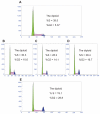Effects of oridonin nanosuspension on cell proliferation and apoptosis of human prostatic carcinoma PC-3 cell line
- PMID: 21042419
- PMCID: PMC2962269
- DOI: 10.2147/IJN.S13537
Effects of oridonin nanosuspension on cell proliferation and apoptosis of human prostatic carcinoma PC-3 cell line
Abstract
This study aims to investigate the inhibitory effects of oridonin nanosuspension on human prostatic carcinoma PC-3 cell line in vitro. The PC-3 cells were incubated with increasing concentrations of oridonin solution and nanosuspensions for 12 hours, 24 hours, and 36 hours. MTT [3-(4,5-dimethylthiazol-2-yl)-2,5-diphenyltetrazolium bromide] assay was performed to measure cellular viability and investigate the effect of oridonin on cell growth of PC-3. Annexin V-FITC/PI staining method was used to determine the effect of oridonin by fluorescence microscope and flow cytometry, respectively. Nanosuspension on early apoptosis of PC-3 cells was also evaluated. Oridonin significantly inhibited the growth of PC-3 cells after 12 hours, 24 hours, and 36 hours of treatment in a dose-dependent manner (P < 0.05). Compared with the same concentration of oridonin solution, oridonin nanosuspension enhanced the inhibition ratio of proliferation. The observation of propidium iodide fluorescence staining confirmed the MTT assay results. The cell proportion of PC-3 at the G2/M phase in the nanosuspension treatment group was upregulated compared with that of the control and oridonin solution groups. Both oridonin solution and nanosuspension promoted the early apoptosis of PC-3 cells. Furthermore, while improving the ratio of early apoptosis, oridonin nanosuspensions also enhanced growth suppression, and induced apoptosis of PC-3 cells. This shows great potential in the treatment of androgen-independent carcinoma of prostate by oridonin nanosuspensions.
Keywords: PC-3 cells; apoptosis; carcinoma of prostate; cell cycle; nanosuspension; oridonin.
Figures






References
-
- Scott SL, Gumerlock PH, Beckett L, Li Y, Goldberg Z. Survival and cell cycle kinetics of human prostate cancer cell lines after single- and multifraction exposures to ionizing radiation. Int J Radiat Oncol Biol Phys. 2004;59(1):219–227. - PubMed
-
- Liou SF, Lin HH, Liang JC, Chen IJ, Yeh JL. Inhibition of human prostate cancer cells proliferation by a selective alpha1-adrenoceptor antagonist labedipinedilol-A involves cell cycle arrest and apoptosis. Toxicology. 2009;256:1–2. 13–24. - PubMed
-
- Ezekwudo D, Shashidharamurthy R, Devineni D, Bozeman E, Palaniappan R, Selvaraj P. Inhibition of expression of anti-apoptotic protein Bcl-2 and induction of cell death in radioresistant human prostate adenocarcinoma cell line (PC-3) by methyl jasmonate. Cancer Lett. 2008;270(2):277–285. - PubMed
Publication types
MeSH terms
Substances
LinkOut - more resources
Full Text Sources
Medical
Research Materials
Miscellaneous

